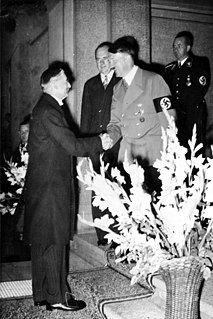 W
WInterwar Britain (1918–1939) was a period of peace and relative economic stagnation. In politics the Liberal Party collapsed and the Labour Party became the main challenger to the dominant Conservative Party throughout the period. The Great Depression affected Britain less severely economically and politically than other major nations, although there were severe pockets of long-term unemployment and hardship, especially in mining districts and in Scotland and North West England.
 W
WAppeasement in an international context is a diplomatic policy of making political or material concessions to an aggressive power in order to avoid conflict. The term is most often applied to the foreign policy of the UK governments of Prime Ministers Ramsay MacDonald, Stanley Baldwin and Neville Chamberlain in office: 1937-1940) towards Nazi Germany and Fascist Italy between 1935 and 1939. Appeasement of Nazism and Fascism also played a role in French foreign policy of the period.
 W
WStanley Baldwin of the Conservative Party formed the second Baldwin ministry upon his reappointment as Prime Minister of the United Kingdom by King George V after the 1924 general election. His second ministry ended following the so-called "Flapper Election" of May 1929.
 W
WThe Conservative Government of the United Kingdom that began in 1922 and ended in 1924 consisted of two ministries: the Law ministry and then the first Baldwin ministry.
 W
WCurzon Street Baroque is a 20th-century inter-war Baroque revival style. It manifested itself principally as a form of interior design popular in the homes of Britain's wealthy and well-born intellectual elite. Its name was coined by the English cartoonist and author Osbert Lancaster, as Curzon Street in Mayfair was an address popular with London high society. While previous forms of Baroque interior design had relied on French 18th-century furnishings, in this form it was more often than not the heavier and more solid furniture of Italy, Spain, and southern Germany that came to symbolise the furnishings of new fashion.
 W
WThe European foreign policy of the Chamberlain ministry from 1937 to 1940 was based on British Prime Minister Neville Chamberlain's commitment to "peace for our time" by pursuing a policy of appeasement and containment towards Nazi Germany and by increasing the strength of Britain's armed forces until, in September 1939, he delivered an ultimatum over the invasion of Poland, which was followed by a declaration of war against Germany.
 W
WInterwar unemployment and poverty in the United Kingdom describes a period of poverty in Interwar Britain between the end of the First World War in 1918 and the start of the Second World War in 1939. Unemployment was the dominant issue of British society during the interwar years. Unemployment levels rarely dipped below 1,000,000 and reached a peak of more than 3,000,000 in 1933, a figure which represented more than 20% of the working population. The unemployment rate was even higher in areas including South Wales and Liverpool. The Government extended unemployment insurance schemes in 1920 to alleviate the effects of unemployment.
 W
WLiberal David Lloyd George formed a coalition government in the United Kingdom in December 1916, and was appointed Prime Minister of the United Kingdom by King George V. It replaced the earlier wartime coalition under H. H. Asquith, which had been held responsible for losses during the Great War. Those Liberals who continued to support Asquith served as the Official Opposition. The government continued in power after the end of the war in 1918, though Lloyd George was increasingly reliant on the Conservatives for support. After several scandals including allegations of the sale of honours, the Conservatives withdrew their support after a meeting at the Carlton Club in 1922, and Bonar Law formed a government.
 W
WThe first MacDonald ministry of the United Kingdom lasted from January to November 1924. The Labour Party, under Ramsay MacDonald, had failed to win the general election of December 1923, with 191 seats, although the combined Opposition tally exceeded that of the Conservative government creating a hung parliament. Stanley Baldwin remained in office until January 1924.
 W
WThe second MacDonald ministry was formed by Ramsay MacDonald on his reappointment as Prime Minister of the United Kingdom by King George V on 5 June 1929. It was only the second occasion on which the Labour Party had formed a government; the First MacDonald Ministry held office in 1924.
 W
WMarchese Piero Luigi Carlo Maria Malacrida de Saint-August was an Italian aristocrat, playboy and London-based interior designer. He and his first wife, the poet Nadja Malacrida, were prominent socialites in London in the late 1920s and early 1930s. Piero Malacrida is best known for his interiors at Eltham Palace. Following the death of Nadja in 1934, Malacrida withdrew from public life, although he later remarried.